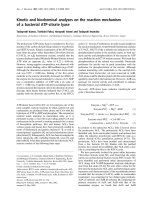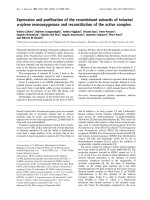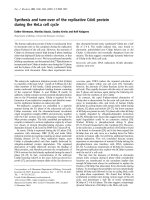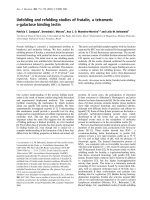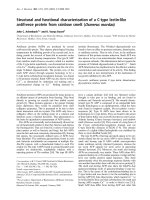Báo cáo y học: "Rapid and persistent selection of the K103N mutation as a majority quasispecies in a HIV1-patient exposed to efavirenz for three weeks: a case report and review of the literature" pot
Bạn đang xem bản rút gọn của tài liệu. Xem và tải ngay bản đầy đủ của tài liệu tại đây (221.25 KB, 5 trang )
Case report
Open Access
Rapid and persistent selection of the K103N mutation as a majority
quasispecies in a HIV1-patient exposed to efavirenz for three weeks:
a case report and review of the literature
Ennio Polilli
1
, Giustino Parruti
2
*, Luana Cosentino
1
, Federica Sozio
2
,
Annalisa Saracino
3
, Augusta Consorte
2
, Gioacchino Angarano
3
,
Francesco Di Masi
2
, Elena Mazzotta
2
and Paolo Fazii
2
Addresses:
1
Clinical Pathology Unit, Ospedale Civile “Spirito Santo”, Via Fonte Romana 8, 65124 Pescara, Italy
2
Infectious Disease Unit, Ospedale Civile “Spirito Santo”, Via Fonte Romana 8, 65124 Pescara, Italy
3
Infectious Disease Department, University of Foggia, “Ospedali Riuniti”, Via L. Pinto 1, 71100 Foggia, Italy
Email: EP - ; GP* - ; LC - ; FS - ; AS - ;
AC - ; GA - ; FDM - ; EM - ;
PF -
* Corresponding author
Received: 16 May 2008 Accepted: 8 May 2009 Published: 18 September 2009
Journal of Medical Case Reports 2009, 3:9132 doi: 10.4076/1752-1947-3-9132
This article is available from: />© 2009 Polilli et al.; licensee Cases Network Ltd.
This is an Open Access article distributed under the terms of the Creative Commons Attribution License (
/>which permits unrestricted use, distribution, and reproduction in any medium, provided the original work is properly cited.
Abstract
Introduction: Selection of the K103N mutation is associated with moderately reduced in vitro
fitness of HIV. Strains bearing K103N in vivo tend to persist, even in the absence of additional drug
pressure, as minority quasispecies, often undetectable in genotyping resistance testing assays,
performed at standard conditions. Here, we report on the rapid and long lasting selection of a K103N
bearing strain as the dominant quasispecies after very short exposure to efavirenz in vivo.
Case presentation: A 55-year-old Caucasian man was switched to efavirenz, zidovudine and
lamivudine in February 2003, while on viral suppression in his first-line highly active anti-retroviral
treatment regimen. One month later, he reported inconsistent adherence and his viremia level was
5700 c/mL. He did not attend further checkups until September 2005, when his viral load was
181,000 c/mL. The patient reported interrupting his medications approximately three weeks after
simplification. The genotyping resistance testing assay was performed both on HIV RNA and HIV
DNA from plasma, yielding an identical pattern with the isolate presence of the K103N mutation in
the prevalent strain.
Conclusion: Persistence of the K103N mutation as a majority quasispecies may ensue after a very
short exposure to efavirenz. Our case would therefore suggest that the presence of the K103N
mutation should always be ruled out by genotyping resistance testing assays, even after minimal
exposures to efavirenz.
Page 1 of 5
(page number not for citation purposes)
Introduction
Non-nucleoside reverse transcriptase inhibitor (NNRTI)-
based highly active anti-retroviral treatment (HAART)
regimens are characterized by a good tolerance of relatively
low levels of adherence to therapy, although resistance
selection may ensue when adherence drops below the
75% threshold [1,2]. First generation NNRTIs have a low
genetic barrier and the K103N mutation is able to confer
class resistance after selection [3,4]. As efavirenz (EFV) and
nevirapine (NVP) have a much longer plasma half-life
than their companion nucleoside reverse transcriptase
inhibitors (NRTIs), residual NNRTI monotherapies asso-
ciated with structured or non-structured therapy interrup-
tions may favor K103N selection. Although selection
of the K103N mutation is associated with moderately
but significantly reduced in vitro fitness [5], strains bearing
K103N in vivo tend to persist even in the absence of
additional drug pressure. K103N persistence, however, is
more frequently observed as a minority quasispecies, often
undetectable in GRT (Genotypic antiretroviral Resistance
Testing) assays performed at standard conditions.
A single dose of NVP administered during delivery in
pregnant women to prevent mother from transmitting HIV
to their babies was able to select K103N mutant strains,
which could persist as minority quasispecies for as long as
five years after drug exposure [6]. Persistence of NNRTI-
induced mutations, and particularly persistence of the
K103N mutation, has also been observed in patients on
treatment interruptions after failure of NNRTI-based
regimens, as well as in patients on f ailing protease
inhibitor (PI)-based regimens after previous NNRTI fail-
ures [7]. In this report, we describe the case of a 55-year-
old HIV-infected man, for whom a quickly selected and
long-term persisting K103N mutation was detected after
a time of exposure to EFV as short as three weeks. The
K103N bearing strain persisted as the dominant quasi-
species for over three years in the absence of any further
drug pressure, as documented by a GRT assay performed at
the end of a long-lasting treatment interruption.
Case presentation
A 55-year-old Caucasian male patient infected with HIV for
more than 10 years after heterosexual exposure, CDC class
C since 1999 due to pneumocystis jiroveci pneumonia, was
put on his first-line HAART regimen in November 1998,
with indinavir, zidovudine (AZT) and lamivudine (LMV).
His virological response was prompt and long lasting. Pre-
HAART viremia level was 215,000 c/mL (5,3Log
10
, no GRT
assay was performed at that time), pre-HAART CD4+
T-lymphocytes were 17/µL. After viral suppression, his
CD4+ T-cell counts very slowly improved, approaching the
200/µL threshold only after 28 months of treatment.
Therefore, his HAART scheme was not simplified, with no
signs of drug-related toxicity ensuing. In February 2003,
however, after approximately four years of treatment, the
patient declared his intention to change his treatment
drugs. According to the patient, he experienced treatment-
related fatigue and had recent adherence failures. His viral
load at that time, however, was still undetectable. His
treatment was therefore switched to EFV, AZT and LMV.
One month later, during his next scheduled control, his
viremia was 5700 c/mL (3,7 Log
10
); he reported incon-
sistent adherence. After that, he did not show up until
March 2006. He was hospitalized due to clinical progres-
sion (high fever and remarkable weight loss), with a
discharge diagnosis of disseminated atypical mycobacter-
iosis. On admission, CD4+ T-cell counts were 12/µL, and
his viral load was 181.000 c/mL (5,2 Log
10
). The patient
reported interruption of all his medications a few days
after his last check in 2003, approximately three weeks
after therapy simplification (Figure 1). Neither a pre-
NNRTI GRT assay was available at that time, nor samples
of plasma drawn in advance of the NNRTI-based
treatment, had been stored. GRT assays, however, were
performed both on HIV RNA and on HIV DNA from
peripheral blood. These proved that HIV infection was due
to clade B HIV-1, both yielding an identical sequence
pattern, with the isolate presence of the K103N mutation
in the prevalent strain (Table 1). The patient was put on a
new PI-based HAART regimen including boosted atazana-
vir, tenofovir and emtricitabine, reaching a prompt and
complete (<40 c/mL) viral suppression after two weeks.
Discussion
Assuming that HIV replication relapsed seven to 14 days
after interruption of the EFV-containing HAART regimen,
our patient was likely exposed to a residual monotherapy
with EFV for some one to two weeks, as pharmacokinetics
data on EFV indicate a serum half-life of 14.6-167.6 hours,
significantly longer than that of AZT(1 to 2hours) and LMV
(8 hours). Furthermore, chromatographic assays for EFV,
performed seven days after the last dose, demonstrated sub-
therapeutic concentrations of EFV in plasma (70-720 ng/
mL) [8]. A GRT had not been performed at the time of first
HIV diagnosis, so straightforward evidence could not be
provided to exclude the presence of the K103N mutation in
our patient in advance of his first line HAART.
He first presented in our ward in 2000, with very advanced
HIV infection (Nadir CD4 counts = 15/mm
3
) and pneumo-
cystis jiroveci pneumonia. He never travelled abroad, and
reported risky heterosexual behaviors up to some 10 years
before presentation. As a consequence, although both the
existence [9] and the transmission [10] of HIV strains
carrying the K103N mutation in NNRTI-naïve patients have
been extensively documented, it is unlikely that our patient
may have been infected with an HIV strain carrying the
K103N mutation, as the widespread use of NNRTIs in Italy
Page 2 of 5
(page number not for citation purposes)
Journal of Medical Case Reports 2009, 3:9132 />began after 1996. Therefore, it is more likely that exposure
to EFV monotherapy at the time of therapy interruption
selected the K103N mutation, which persisted as the
prevalent quasispecies for over 3 years of continual viral
replication, in the absence of selective pressure.
Our experience is therefore very similar to the observed
scenario of HIV-infected women exposed to a single dose of
NVP for prevention of mother-to-child HIV transmission.
Reports on such women, however, indicate that the K103N
quasispecies were present as a minority quasispecies in
most described cases [6,11,12]. Similarly, by means of high
sensitivity sequencing techniques, Palmer et al. reported on
the persistence of K103N mutation after EFV interruption
in patients failing to EFV-containing regimens, document-
ing variable decay kinetics for the K103N containing
quasispecies. Such quasispecies most frequently decayed
and disappeared after a few weeks, but less frequently so,
after a few months. In one patient, strains carrying K103N
mutation persisted for six years as dominant quasispecies,
in the absence of selective pressure, after administration of
EFV for a year and a half. In such a case, the authors
postulated a possible eradication of the wild type quasis-
pecies before HAART failure [13]. Capetti et al. reported the
case of a HIV-infected woman who, seven years after
exposure to a failing loviride-containing HAART regimen,
presented the K103N mutation at a later viral relapse,
without further exposure to any NNRTI selective pressure
for as long as seven years after loviride. This patient,
however, had been kept under prolonged viral suppression
on protease inhibitor (PI)-containing HAART regimens,
likely limiting viral replicative competition [14]. In our
patient, persistence of the K103N-containing quasispecies
ensued after a short exposure to EFV, in the absence of any
further selective pressure. Therefore, it likely depended on a
relatively small decrease in viral fitness of this prevalent
quasispecies relative to wild type.
It is now well-known that NNRTIs bind a hydrophobic site
adjacent with the enzyme active site of HIV reverse
24/05/1999 22/11/2000 15/01/2002
1.7
2.7
3.7
4.7
5.7
6.7
7.7
8.7
9.7
5
45
85
125
165
205
245
285
325
365
405
445
485
CD4
HIV-RNA
17/03/2006 23/08/2006 02/07/2007
RNA (Log)
CD4
AZT
IDV
3TC
EFV
ATV/r
FTC
TDF
GRT
Figure 1. Human immunodeficiency virus viremia, CD4+ T-cell counts and therapy during follow-up (3TC Lamivudine, AZT
Zidovudine, ATV Atazanavir, IDV Indinavir, EFV Efavirenz, TDF Tenofovir, FTC Emtricitabine, GRT Genotyping Resistance
Testing).
Table 1. GRT of proviral and plasma HIV, as interpreted by the Stanford
HIV database algorithm (as of March, 2006)
HIV-DNA resistance
mutations
HIV-RNA resistance
mutations
PI Major Resistance
Mutations:
None None
PI Minor Resistance
Mutations:
L10V None
PI Other Mutations: I15V V11FV
R41K E35D
L63P N37NS
R41K
P44LP
R57K
L63P
G94GRS
NRTI Resistance
Mutations:
None None
NNRTI Resistance
Mutations:
K103N K103N
RT Other Mutations: K64R
R211K
V245Q
K30Q, K32GRS,
A33C, L34T, V35L,
E36N, I37F, K46KT,
V148EV, Q174LQ,
R211K, V245Q
Page 3 of 5
(page number not for citation purposes)
Journal of Medical Case Reports 2009, 3:9132 />transcriptase, inducing an allosteric modification of the
active site influencing enzyme performance [15]. Collins
et al., applied a fitness assay to several NNRTI drug-
resistant quasispecies, demonstrating that the wild type
had a better fitness than K103N-bearing quasispecies, and
that the fitness rank for other NNRTI mutation-carrying
quasispecies was 181C > 190A > 188C > 106A.
Furthermore, they demonstrated that double and triple
NNRTI mutation-carrying quasispecies had worse fitness
than single mutation carrying quasispecies [5]. Along a
different line of evidence, Hatano et al. recently demon-
strated that failing NNRTI-based HAART regimens do not
confer clinical residual advantage, at variance with PI-
based failing HAART regimens. This observation would
suggest that unlike PI-induced mutations, NNRTI-induced
mutations do not significantly alter fitness of mutation-
carrying quasispecies [16].
This scenario confirms the result of Fox et al. 2008, and
highlights the need to interrupt NNRTI-based regimens
wisely. Patients of the SMART study interrupting NNRTI-
based regimens restarted later on the same regimen. Fox
et al. demonstrated that patients on staggered interrup-
tions (interruption of NRTIs one week after that of the
NNRTI) or switched interruptions (replacement of the
NNRTI with a boosted PI for a short period) of all drugs
were less likely than those using simultaneous interrup-
tions to have any NNRTI mutation in their GRT performed
two months following the treatment interruption. They
also demonstrated that patients who carried a NNRTI-
mutation after the interruption achieved viral resuppres-
sion significantly less frequently than those who did not
have any mutation in their resistance test [17].
Conclusion
Our experience, although similar to that reported by
Palmer et al. on one of their patients, would indicate that
persistence of the K103N mutation as a majority
quasispecies may ensue after a very short exposure to
EFV, in the absence of wild type depletion, likely providing
relative replicative advantage.
Our case therefore suggests that the presence of the K103N
mutation should be ruled out even after m inimal
exposures to EFV, reinforcing at the same time the need
for a systematic evaluation of GRT in naïve patients and
after any type of interruption of NNRTI-based HAART
regimens, as well as the need for a wise strategy of NNRTI
interruption.
Abbreviations
μL, microliter; EFV, efavirenz; GRT, genotypic antiretro-
viral resistance testing; HAART, highly active antiretroviral
therapy; mL, milliliter; ng, nanogram; NNRTI, non-
nucleoside reverse transcriptase inhibitor; NVP, nevirapine;
PI, protease inhibitor.
Competing interests
The authors declare that they have no competing interests.
Consent
Written informed consent was obtained from the patient
for publication of this case report and any accompanying
images. A copy of the written consent is available for
review by the Editor-in-Chief of this journal.
Authors’ contributions
EP, GP, AC, FDM and PF ideated this case report after
observation of the GRT results, and did most of the
writing, supported by FS and EM; LC and EP performed
RNA sequencing and sequence interpretation; AS and GA
contributed the DNA results and critical counselling.
Acknowledgements
We are sincerely indebted with Mrs. Loredana Puglielli,
chief nurse in the Infectious Disease Unit, for assistance
with this case report. We are also indebted with
Mr. Paolo De Cono, for assistance with laboratory assays.
Dr. E. Polilli was funded by an educational grant from the
“Fondazione Camillo de Lellis per l’Innovazione e la
Ricerca in Medicina”, Pescara, Italy.
References
1. Maggiolo F, Ravasio L, Ripamonti D, Gregis G, Quinzan G, Arici C,
Airoldi M, Suter F: Similar adherence rates favor different
virologic outcomes for patients treated with nonnucleoside
analogues or protease inhibitors. Clin Infect Dis 2005, 40:
158-163.
2. Bangsberg DR, Acosta EP, Gupta R, Guzman D, Riley ED, Harrigan PR,
Parkin N, Deeks SG: Adherence-resistance relationships for
protease and non-nucleoside reverse transcriptase inhibitors
explained by virological fitness. AIDS 2006, 20:223-231.
3. Delaugerre C, Rohban R, Simon A, Mouroux M, Tricot C, Agher R,
Huraux JM, Katlama C, Calvez V: Resistance profile and cross-
resistance of HIV-1 among patients failing a non-nucleoside
reverse transcriptase inhibitor-containing regimen. J Med Virol
2001, 65:445-448.
4. Bacheler L, Jeffrey S, Hanna G, D’Aquila R, Wallace L, Logue K,
Cordova B, Hertogs K, Larder B, Buckery R, Baker D, Gallagher K,
Scarnati H, Tritch R, Rizzo C: Genotypic correlates of pheno-
typic resistance to efavirenz in virus isolates from patients
failing nonnucleoside reverse transcriptase inhibitor therapy.
J Virol 2001, 75:4999-5008.
5. Collins JA, Thompson MG, Paintsil E, Ricketts M, Gedzior J,
Alexander L: Competitive Fitness of Nevirapine-Resistant
Human Immunodeficiency Virus Type 1 Mutants. Journal of
Virology 2004, 78:603-611.
6. Flys T, Donnell D, Mwatha A, Nakabiito C, Musoke P, Mmiro F,
Jackson JB, Guai LA, Eshleman SH: Persistence of K103N-
contening HIV1 variants after single dose nevirapine for
prevention of HIV1 mother to child transmission. J Infect Dis
2007, 195:711-715.
7. Joly V, Descamps D, Peytavin G, Touati F, Mentre F, Duval X,
Delarue S, Yeni P, Brun-Vezinet F: Evolution of human immuno-
deficiency virus typ e 1 (HIV-1) resistance mutations in
Page 4 of 5
(page number not for citation purposes)
Journal of Medical Case Reports 2009, 3:9132 />nonnucleoside reverse transcriptase inhibitors (NNRTIs) in
HIV-1-infected patients switched to antiretroviral therapy
without NNRTIs. Antimicrob Agents Chemother 2004, 48:172-175.
8. Dybul M, Nies-Kraske E, Dewar R, Maldarelli F, Hallahan CW,
Daucher M, Piscitelli SC, Ehler L, Weigand A, Palmer S, Metcalf JA,
Davey RT, Rock Kress DM, Powers A, Beck I, Frenkel L, Baseler M,
Coffin J, Fauci AS: A proof-of-concept study of short-cycle
intermittent antiretroviral therapy with a once-daily regimen
of didanosine, Lamivudine, and efavirenz for the treatment of
chronic HIV infection. J Infect Dis 2004, 189:1974-1982.
9. Weinstock H, Respess R, Heneine W, Petropoulos CJ, Hellmann NS,
Luo CC, Pau CP, Woods T, Gwinn M, Kaplan J: Prevalence of
mutations as sociated with reduced antiretroviral drug
susceptibility among human immunodeficiency virus type 1
seroconverters in the United States, 1993-1998. J Infect Dis
2000, 182:330-333.
10. Imrie A, Beveridge A, Genn W, Vizzard J, Cooper DA: Transmission
of human immunodeficiency virus type 1 resis tant to
nevirapine and zidovudine. Sydney Primary HIV Infection
Study Group. J Infect Dis 1997, 175:1502-1506.
11. Flys T, Nissley DV, Claasen CW, Jones D, Shi C, Guay LA, Musoke P,
Mmiro F, Strathern JN, Jackson JB, Eshleman JR, Eshleman SH:
Sensitive drug-resistance assays reveal long-term persistence
of HIV-1 variants with the K103N nevirapine (NVP) resis-
tance mutation in some women and i nfants after the
administration of single-dose NVP: HIVNET 012. J Infect Dis
2005, 192:24-29.
12. Taylor S, Boffito M, Khoo S, Smit E, Back D: Stopping antire-
troviral therapy. AIDS 2007, 21:1673-1682.
13. Palmer S, Boltz V, Maldarelli F, Gray G, McIntyre J, Mellors J, Morris L,
Coffin J: Selection and persistence of non-nucleoside reverse
transcriptase inhibitor-resistant HIV-1 in patients starting
and stopping non-nucleoside therapy. AIDS 2006, 20:701-710.
14. Capetti AF, Gabrisa AI, Drago L, Vigevania G: Can a K103N HIV
strain stably overcome the wild type in the absence of non-
nucleoside reverse transcriptase inhibitor selective pressure?
AIDS 2005, 19:633-640.
15. Sluis-Cremer N, Temiz AN, Bahar I: Conformational changes in
HIV1 Reverse Trascriptase induced by Non Nucleoside Reverse
Transciptase Inhibitor Binding. Curr HIV Res 2004, 2:323-332.
16. Hatano H, Hunt P, Weidler J, Coakley E, Hoh R, Liegler T,
McCulloch C, Martin J, Deeks SG: Repeated measures analysis
of plasma HIV-1 RNA levels in HIV-infected patients
remaining on a stable partially suppressive regimen. 4th IAS
conference on HIV22-25-2007, Sydney, Australia.
17. Fox Z, Phillips A, Cohen C, Neuhaus J, Baxter J, Emery S, Hirschel B,
Hullsiek KH, Stephan C, Lundgren J; SMART Study Group: Viral
resuppression and detection of drug resistance following
interruption of a suppressive non-nucleoside reverse tran-
scriptase inhibitor-based regimen. AIDS 2008, 22:2279-2289.
Do you have a case to share?
Submit your case report today
• Rapid peer review
• Fast publication
• PubMed indexing
• Inclusion in Cases Database
Any patient, any case, can teach us
something
www.casesnetwork.com
Page 5 of 5
(page number not for citation purposes)
Journal of Medical Case Reports 2009, 3:9132 />



